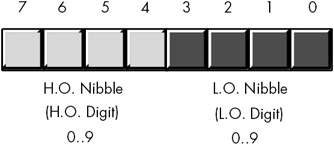2.14 Binary Coded Decimal (BCD) Representation
|
2.14 Binary Coded Decimal (BCD) Representation
Although the integer and floating point formats cover most of the numeric needs of an average program, there are some special cases where other numeric representations are convenient. In this section we'll discuss the binary coded decimal (BCD) format because the 80x86 CPU provides a small amount of hardware support for this data representation.
BCD values are a sequence of nibbles with each nibble representing a value in the range 0..9. Of course, you can represent values in the range 0..15 using a nibble; the BCD format, however, uses only 10 of the possible 16 different values for each nibble.
Each nibble in a BCD value represents a single decimal digit. Therefore, with a single byte (i.e., two digits) we can represent values containing two decimal digits, or values in the range 0..99 (see Figure 2-27). With a word, we can represent values having four decimal digits, or values in the range 0..9999. Likewise, with a double word we can represent values with up to eight decimal digits (because there are eight nibbles in a double word value).

Figure 2-27: BCD Data Representation in Memory.
As you can see, BCD storage isn't particularly memory efficient. For example, an 8-bit BCD variable can represent values in the range 0..99 while that same 8 bits, when holding a binary value, can represent values in the range 0..255. Likewise, a 16-bit binary value can represent values in the range 0..65535 while a 16-bit BCD value can only represent about 1/6 of those values (0..9999). Inefficient storage isn't the only problem. BCD calculations tend to be slower than binary calculations.
At this point, you're probably wondering why anyone would ever use the BCD format. The BCD format does have two saving graces: It's very easy to convert BCD values between the internal numeric representation and their string representation; also, it's very easy to encode multidigit decimal values in hardware (e.g., using a "thumb wheel" or dial) using BCD than it is using binary. For these two reasons, you're likely to see people using BCD in embedded systems (e.g., toaster ovens and alarm clocks) but rarely in general purpose computer software.
A few decades ago people mistakenly thought that calculations involving BCD (or just "decimal") arithmetic were more accurate than binary calculations. Therefore, they would often perform "important" calculations, like those involving dollars and cents (or other monetary units) using decimal-based arithmetic. While it is true that certain calculations can produce more accurate results in BCD, this statement is not true in general. Indeed, for most calculations (even those involving fixed point decimal arithmetic), the binary representation is more accurate. For this reason, most modern computer programs represent all values in a binary form. For example, the Intel 80x86 floating point unit (FPU) supports a pair of instructions for loading and storing BCD values. Internally, however, the FPU converts these BCD values to binary and performs all calculations in binary. It only uses BCD as an external data format (external to the FPU, that is). This generally produces more accurate results and requires far less silicon than having a separate coprocessor that supports decimal arithmetic.
|
EAN: 2147483647
Pages: 246
- Chapter I e-Search: A Conceptual Framework of Online Consumer Behavior
- Chapter III Two Models of Online Patronage: Why Do Consumers Shop on the Internet?
- Chapter IV How Consumers Think About Interactive Aspects of Web Advertising
- Chapter VII Objective and Perceived Complexity and Their Impacts on Internet Communication
- Chapter XIII Shopping Agent Web Sites: A Comparative Shopping Environment